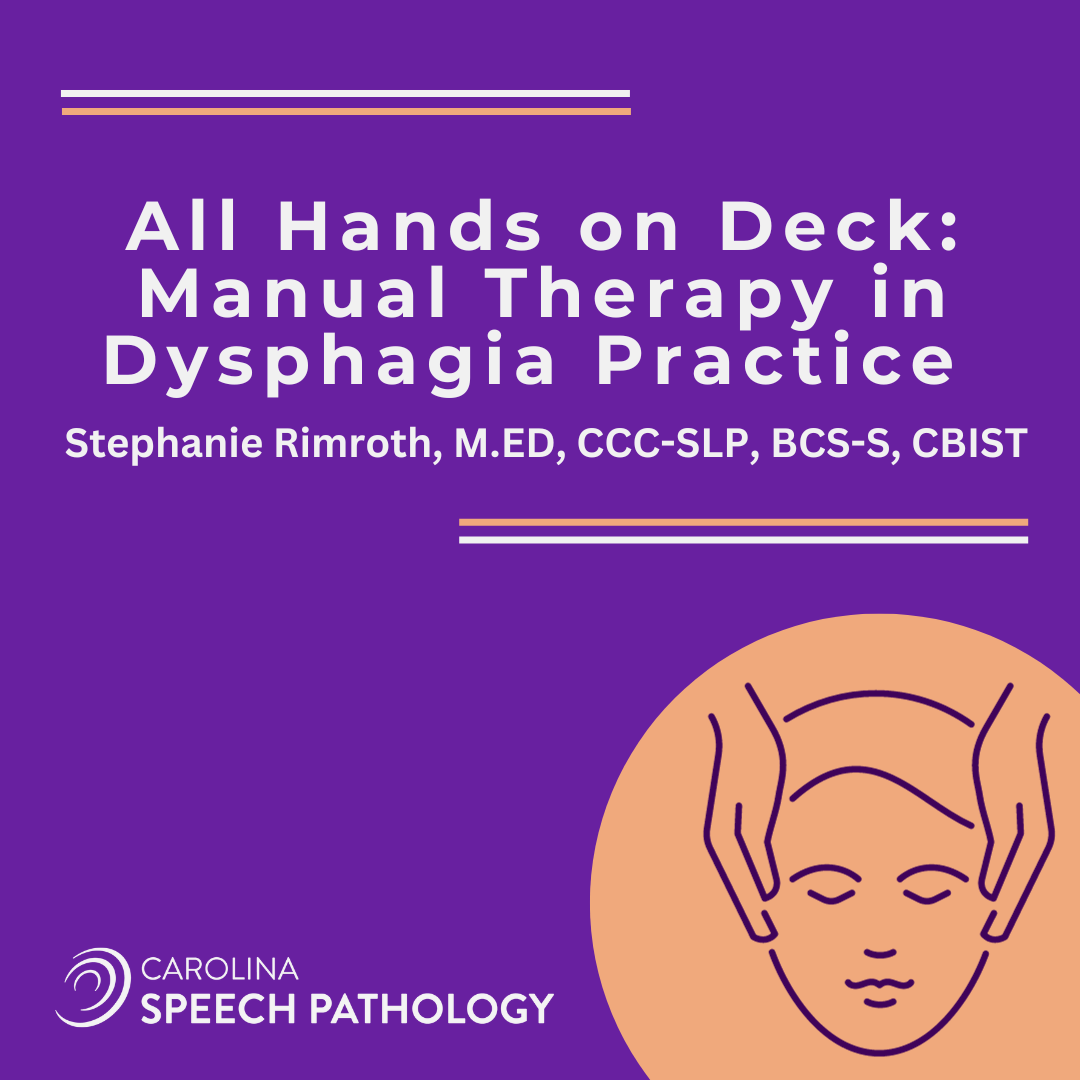As speech pathologists, we are passionate about what we do. We are constantly seeking innovative ways to improve therapeutic outcomes for our patients. We know as clinicians that dysphagia can severely impact an individual’s quality of life. This alone makes it essential for us to explore all avenues for effective treatment. While traditional techniques have their place, incorporating manual therapy into dysphagia practice has emerged as a highly effective and beneficial adjunct method of care.
Come join me! Dive into why we, as SLPs, should target improving therapeutic outcomes for individuals with dysphagia through incorporating manual therapy.
Manual therapy involves skilled, hands-on techniques aimed at improving tissue mobility, reducing muscular tension, and enhancing overall function. When applied to our dysphagia practice, we, as SLPs can target specific muscles and structures involved in swallowing, promote improved swallowing patterns, and even reduce pain and discomfort. Manual therapy has become a game-changer in my practice, enabling me to achieve improved outcomes for my patients.
Let’s dive into my personal experience and the impact it has had on my ability to improve my dysphagia treatment.
Like many professionals in my field, I was initially skeptical about the potential benefits of manual therapy. However, year after year working side-by-side with PTs and OTs I could not discount the impact they had on their patients when utilizing manual therapy.
It made me wonder – why not us too?
We all know there are over 30 muscles involved in the swallow.
Yes, we have exercises, but what if those muscles are tight?
What is the surrounding tissue is restricted?
What if there is lymph fluid present??
After attending a series of workshops and seminars, I became intrigued by the idea of incorporating hands-on techniques into my treatment. It didn’t take long to realize; that our patients need manual therapy too. Not from PTs or OTs, but from well-trained SLPs, ones like us who understand the mechanisms of each swallow phase.
Manual therapy has the potential to address the underlying musculoskeletal and structural issues contributing to dysphagia, leading to more efficient and holistic therapy; moreover, it gave me a new level on which I can connect with each of my patients. When they describe something, I am no longer looking to just see it, or trying to imagine it, I can feel it – and I can adjust my hand positioning and my pressure based on the feedback I receive during the treatment session.
Change can be scary!
I will be the first to admit – but evolution is the key to maintain the leading role in our dysphagia patients’ care. Witnessing the positive impact manual therapy techniques have on my patients’ swallowing function continues to reinforce my belief in the power of hands-on interventions. As a speech-language pathologist, I am committed to continually refining my skills and expanding my knowledge to provide my patients with the most effective and comprehensive dysphagia treatment possible. Manual therapy has become an indispensable tool in my arsenal, enabling me to optimize outcomes and enhance the quality of life for individuals struggling with dysphagia.
Would you like to learn more about implementing manual therapy into your practice? We have a webinar coming up on this very topic. All Hands on Deck: Introducing Manual Therapy You’re your Dysphagia Practice takes place live on February 8, 2024 from 12:00 pm to 2:00 pm (Eastern Time). Can’t make it? No problem! The recording will be available from February 9, 2024 through February 29, 2024. We hope you’ll come learn with us!
About the author: Stephanie Rimroth M.Ed, CCC-SLP, BCS-S, CBIST earned her Master’s in Communication Disorders at the University of Virginia in Charlottesville, Virginia, and has since worked in acute care, acute rehab, skilled nursing, and outpatient settings. She is currently 1 of 12 Active Duty Speech-Language Pathologists serving as a Lieutenant in the United States Public Health Service Corps. Stephanie is stationed at Eglin AFB in the Neurology Clinic where she developed the Neurology Clinic’s Outpatient Speech-Pathology Program. In addition, she collaborates with Eglin Pediatrics for infant feeding/swallowing and Eglin Dental for oral pain and temporomandibular joint disorder. Stephanie holds supplemental positions assessing and treating patients at Ascension Sacred Heart Hospital on the Emerald Coast assessing and treating acute care adults and pediatrics in the neonatal intensive care unit. Stephanie has been instrumental in developing outpatient and adult speech pathology programs, as well as securing funding and implementing fiberoptic endoscopic evaluation of swallowing (FEES) programs. Stephanie has been utilizing various techniques and styles of manual therapy in her practice for over 7 years and recently completed Orofacial Myofunctional Therapy Training through AOMT. Stephanie has a special interest in neurological diseases and disorders and dysphagia management.
Disclosures: Ms. Rimroth will receive access to continuing education courses in lieu of financial pay for teaching this course. Ms. Rimroth has no non-financial relationships to disclose.

